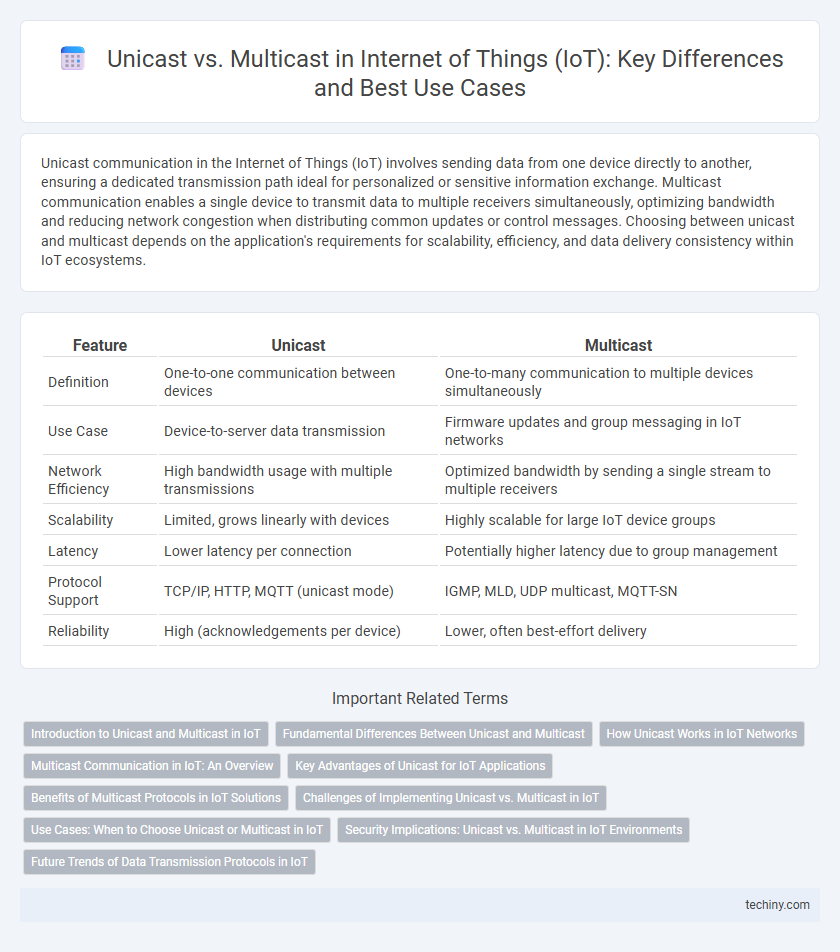Unicast communication in the Internet of Things (IoT) involves sending data from one device directly to another, ensuring a dedicated transmission path ideal for personalized or sensitive information exchange. Multicast communication enables a single device to transmit data to multiple receivers simultaneously, optimizing bandwidth and reducing network congestion when distributing common updates or control messages. Choosing between unicast and multicast depends on the application's requirements for scalability, efficiency, and data delivery consistency within IoT ecosystems.
Table of Comparison
| Feature | Unicast | Multicast |
|---|---|---|
| Definition | One-to-one communication between devices | One-to-many communication to multiple devices simultaneously |
| Use Case | Device-to-server data transmission | Firmware updates and group messaging in IoT networks |
| Network Efficiency | High bandwidth usage with multiple transmissions | Optimized bandwidth by sending a single stream to multiple receivers |
| Scalability | Limited, grows linearly with devices | Highly scalable for large IoT device groups |
| Latency | Lower latency per connection | Potentially higher latency due to group management |
| Protocol Support | TCP/IP, HTTP, MQTT (unicast mode) | IGMP, MLD, UDP multicast, MQTT-SN |
| Reliability | High (acknowledgements per device) | Lower, often best-effort delivery |
Introduction to Unicast and Multicast in IoT
Unicast communication in IoT involves one-to-one data transmission, where a single device sends information directly to another specific device, ensuring targeted and reliable data exchange. Multicast enables one-to-many communication by allowing a device to send a single message to multiple devices simultaneously, optimizing network bandwidth and reducing latency in large-scale IoT deployments. Efficient management of unicast and multicast transmissions is crucial for scalable and energy-efficient IoT networks.
Fundamental Differences Between Unicast and Multicast
Unicast communication in the Internet of Things (IoT) involves sending data from one device directly to another specific device, ensuring individualized data transmission with a one-to-one connection. Multicast, in contrast, allows a single device to transmit data simultaneously to multiple devices within a group, optimizing network resources by reducing bandwidth usage for one-to-many communication scenarios. The fundamental difference lies in the traffic delivery method, where unicast targets a single recipient per transmission and multicast targets multiple recipients with a single transmission.
How Unicast Works in IoT Networks
Unicast in IoT networks involves direct communication between a single sender and a specific receiver device, enabling precise data transmission for applications such as sensor reading and command execution. Each IoT node maintains a unique IP address, allowing targeted message delivery through protocols like MQTT or CoAP, minimizing network congestion and ensuring reliable connectivity. This method supports scalable device-to-device interaction crucial for managing individual IoT components within smart home, industrial automation, or healthcare environments.
Multicast Communication in IoT: An Overview
Multicast communication in IoT enables efficient data transmission by allowing a single sender to simultaneously deliver information to multiple devices, reducing network congestion and bandwidth consumption compared to unicast. This approach is essential for scalable IoT deployments, where sensor nodes or smart devices require synchronized updates or group control commands. Protocols like MQTT-SN and CoAP support multicast, facilitating real-time, low-latency communication critical for smart city applications, industrial automation, and connected healthcare systems.
Key Advantages of Unicast for IoT Applications
Unicast communication in IoT applications offers targeted data transmission, ensuring reliable and secure delivery between a single sender and receiver, which reduces interference and conserves network resources. It enhances device-specific interactions, supporting personalized and real-time data exchange critical for applications such as remote monitoring and control. The precision of unicast reduces packet loss and latency, improving the performance of IoT networks in environments requiring high accuracy.
Benefits of Multicast Protocols in IoT Solutions
Multicast protocols in IoT solutions enable efficient bandwidth utilization by transmitting data to multiple devices simultaneously, reducing network congestion and latency. This approach enhances scalability for large-scale IoT deployments, supporting millions of connected devices with minimal resource consumption. Improved energy efficiency and faster data dissemination further optimize performance in constrained IoT networks.
Challenges of Implementing Unicast vs. Multicast in IoT
Implementing unicast in IoT poses scalability challenges due to its one-to-one communication model, resulting in higher network congestion and increased latency when managing numerous devices. Multicast offers efficient one-to-many data transmission but struggles with device heterogeneity and dynamic group membership management in diverse IoT environments. Security and reliability concerns further complicate multicast deployment, requiring robust protocols to handle packet loss and unauthorized access across interconnected IoT nodes.
Use Cases: When to Choose Unicast or Multicast in IoT
Unicast communication in IoT is ideal for personalized device interactions, such as remote monitoring of individual sensors or controlling smart home appliances where targeted data exchange is required. Multicast suits applications involving simultaneous data delivery to multiple devices, like firmware updates for connected sensors or real-time alerts in smart city infrastructure. Choosing unicast or multicast depends on network efficiency and data delivery needs, with multicast reducing bandwidth usage in large-scale IoT deployments.
Security Implications: Unicast vs. Multicast in IoT Environments
Unicast communication in IoT environments offers enhanced security by establishing direct, encrypted channels between individual devices, reducing exposure to unauthorized access. Multicast, though efficient for group data transmission, inherently risks broader attack surfaces due to its one-to-many nature, complicating key management and increasing vulnerability to eavesdropping or data injection attacks. Implementing robust authentication and encryption protocols is critical in mitigating multicast security challenges compared to the more controlled unicast interactions.
Future Trends of Data Transmission Protocols in IoT
Future trends in IoT data transmission highlight a shift from traditional unicast to efficient multicast protocols, optimizing bandwidth and reducing latency for large-scale device communication. Advanced multicast strategies leverage edge computing and AI-driven traffic management to enhance scalability and security in IoT networks. Emerging standards like IPv6-based multicast and 5G multicast broadcasting are poised to support massive IoT deployments with improved reliability and lower power consumption.
Unicast vs Multicast Infographic

 techiny.com
techiny.com